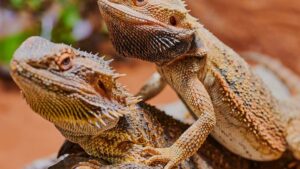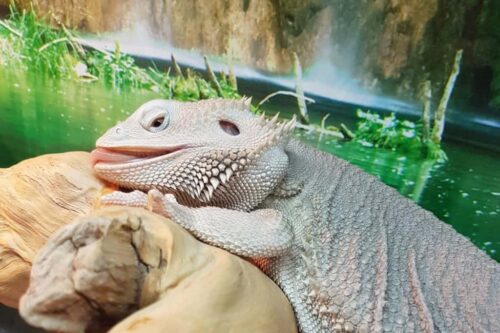Owning a bearded dragon is a rewarding experience, but when your reptile companion starts showing signs of dehydration, it can be alarming. A dehydrated bearded dragon may exhibit troubling symptoms like lethargy, sunken eyes, or wrinkled skin, leaving you wondering how to help.
Don’t worry—you’re in the right place! This guide dives deep into how to recognize dehydration, what causes it, and how to effectively address and prevent this common issue. Whether you’re a seasoned reptile enthusiast or a first-time owner, understanding dehydration in bearded dragons is vital for their health and well-being.
Signs of Dehydration in Bearded Dragons

Recognizing dehydration early can make all the difference. Here’s what to look for:
Physical Symptoms
| Symptom | Description |
|---|---|
| Sunken Eyes | Eyes appear recessed and less vibrant than usual. |
| Wrinkled Skin | Skin looks loose or saggy; may not bounce back quickly after pinching. |
| Lethargy | Reduced activity; your dragon may spend more time lying down or hiding. |
| Loss of Appetite | Refusal to eat or diminished interest in food. |
Behavioral Changes
- Decreased basking or hiding more than usual.
- Unusual defecation patterns, such as dry or infrequent stool.
Skin Pinch Test
Performing a skin pinch test is a quick way to assess hydration:
- Gently pinch the loose skin on the dragon’s side.
- Release and observe how quickly the skin returns to normal.
- Normal: Skin snaps back immediately.
- Dehydrated: Skin remains tented for a second or more.
Common Causes of Dehydration
Understanding the root causes can help you prevent dehydration in the future.
Environmental Factors
- Low Humidity Levels: Bearded dragons require 30–40% humidity in their enclosure.
- High Temperatures: Overheating can dehydrate your dragon quickly. Ensure the basking area is between 95–110°F and the cool side remains around 75–85°F.
Dietary Reasons
| Potential Cause | Explanation |
|---|---|
| Lack of Moisture-Rich Foods | Feeding primarily dry foods like insects without hydrating them. |
| Improper Water Provision | Water bowls that are too deep, dirty, or difficult for your dragon to access. |
Health Issues
- Parasites or infections can lead to fluid loss.
- Stress or illness may cause reduced water intake.
How to Rehydrate a Dehydrated Bearded Dragon

If your bearded dragon shows signs of dehydration, act quickly with these steps:
Immediate Actions
- Offer Fresh Water:
Use a shallow dish of clean, chlorine-free water. Gently dip the dragon’s snout to encourage drinking. - Warm Soak:
A 10–15 minute soak in lukewarm water (85–90°F) can rehydrate your dragon and stimulate drinking. Ensure the water is shallow enough to prevent drowning. - Syringe or Dropper Feeding:
- Fill a syringe with water or an electrolyte solution (like Pedialyte diluted 1:1 with water).
- Place a drop on the dragon’s snout and let them lick it off.
- Misting:
Lightly mist your dragon’s body or enclosure. Some dragons lick droplets off their skin or surfaces.
Incorporating Hydration into Their Diet
| Food | Water Content (%) | Notes |
|---|---|---|
| Cucumber | 95% | Peel and slice into small pieces. |
| Zucchini | 94% | Offer raw and finely chopped. |
| Watermelon | 92% | Use sparingly due to high sugar content. |
| Leafy Greens (Collards, Mustard Greens) | 85–90% | Hydrating and nutrient-rich. |
Preventing Dehydration in Bearded Dragons
The best way to handle dehydration is to prevent it altogether.
Daily Practices
- Fresh Water: Provide clean water daily in a shallow, accessible dish.
- Routine Misting: Some dragons enjoy licking water droplets from their skin or environment.
Balanced Diet
- Include moisture-rich vegetables and occasional fruits.
- Gut-load feeder insects with water-rich foods before feeding them to your dragon.
Optimal Enclosure Setup
| Aspect | Ideal Range | Tools to Monitor or Adjust |
|---|---|---|
| Humidity | 30–40% | Hygrometer to measure and maintain levels. |
| Basking Temperature | 95–110°F | Use a reliable heat lamp with a thermometer. |
| Cool Side Temperature | 75–85°F | Provide shaded areas for cooling. |
When to Consult a Vet
Sometimes, dehydration may require professional intervention. Contact an exotic pet veterinarian if:
- Symptoms persist despite rehydration efforts.
- Your dragon shows severe lethargy or drastic weight loss.
- You suspect an underlying illness (e.g., parasites or infection).
FAQs About Dehydrated Bearded Dragons
How Often Should I Bathe My Bearded Dragon?
Bathing 1–2 times a week is usually sufficient to keep them hydrated and clean.
Can I Add Electrolytes to Their Water?
Yes, but only in moderation and for short-term use. Dilute solutions like Pedialyte can help in cases of dehydration.
Is It Normal for My Dragon to Drink Little Water?
Yes, bearded dragons get most of their hydration from food and environmental moisture. However, they should still have access to water.
Conclusion
A dehydrated bearded dragon can be a cause for concern, but with quick action and proper care, you can restore your pet’s health and prevent future issues. From recognizing the signs to implementing effective hydration practices, this guide equips you with the knowledge to ensure your dragon thrives.
Remember, prevention is key—maintaining proper tank conditions and offering a balanced diet will go a long way in keeping your bearded dragon happy and healthy.

